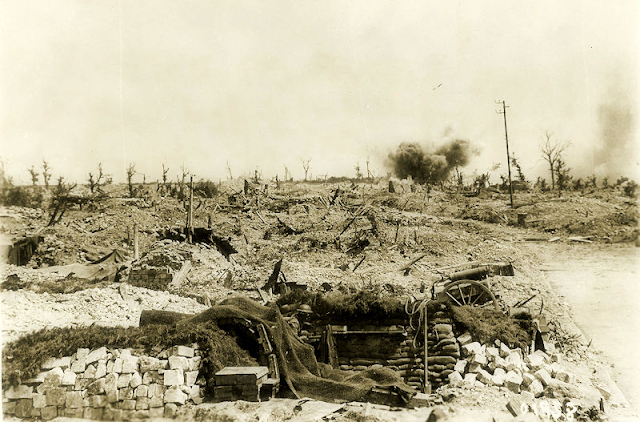 |
| Canadian Trench Closest to Hill 70 |
The capture of Hill 70 in France was an important Canadian victory during the First World War and the first major action fought by the Canadian Corps under a Canadian commander. The battle, in August 1917, gave the Allied forces a crucial strategic position overlooking the occupied city of Lens.
Lieutenant General Arthur Currie took command of the Canadian Corps in June 1917, following the Corps' victory at Vimy Ridge. Replacing British General Julian Byng, Currie was the first Canadian put in charge of the corps, Canada's main fighting force on the Western Front.
 |
| German Strongpoint Defending Hill 70 |
In July, Currie received orders from Sir Douglas Haig, commander-in-chief of all British-led forces in western Europe, to capture the French coal-mining city of Lens. Haig hoped this action would divert German attention and military resources away from the major Allied offensive then raging at Passchendaele, in Belgium.
Lens, which lay inside German-occupied territory not far from Vimy Ridge, had suffered terribly in the war. The Canadians were sent to capture a city that lay half in ruins. Currie thought that Hill 70—an elevation on the outskirts of Lens, so named because it was 70 meters above sea level—was tactically more important. He believed that a traditional, frontal assault on Lens, followed by an Allied occupation of the city, would be futile if the Germans could simply shoot down at the Canadians from the commanding hills. So Currie convinced his superiors, including Haig, to drastically alter the plan of attack, by making Hill 70 the Canadians' main objective.
Currie believed that by capturing the hill he could aggravate the Germans in surrounding positions and provoke them to come out of their dugouts and attack. The Canadians could then kill large numbers of the enemy and drive them out of the area.
Throughout late July and early August, as the Canadians prepared to assault Hill 70, they harassed and distracted the German forces.
Hill 70 was a treeless elevation that dominated Lens. The city itself had been bashed by years of warfare, and German trenches cut through the ruins of the brick homes of the city's coal miners. The ruins offered plenty of cover for the Germans in the city.
The Canadians eventually captured the heights of Hill 70, but the cost was high. By the end of only the first day, 1,056 Canadians were dead, 2,432 were wounded, and 39 had been taken prisoner. It's not known how many Germans died that day.
 |
| Memorial at Hill 70 Under Construction (Opened 2017) |
Fighting continued around Hill 70 through 18 August, with the Canadian Corps withstanding continued German resistance and counterattacks, in localized fighting that included mustard gas and flamethrowers. After four days of hard combat, the Canadians turned back 21 German counter attacks and held on to their new positions atop Hill 70. About 9,000 Canadians were killed or wounded in the overall battle, while an estimated 25,000 Germans were killed or wounded.
The fighting at Hill 70, overshadowed by the more famous Canadian battles at Vimy Ridge in April 1917 and at Passchendaele in the fall of that year, is not as well known to many students of the war. However, some historians argue that Hill 70 was one of Canada's most significant contributions of the First World War, more important even than Vimy Ridge. A memorial to the Canadians who fought at Hill 70 was finally dedicated.
From The Canadian Encyclopedia article by Brereton Greenhous and Jon Tattrie


Hill 70 is on the bucket list of many Canadians.
ReplyDeleteSoldiers who have served next to Canadians know how tough they are...
ReplyDelete